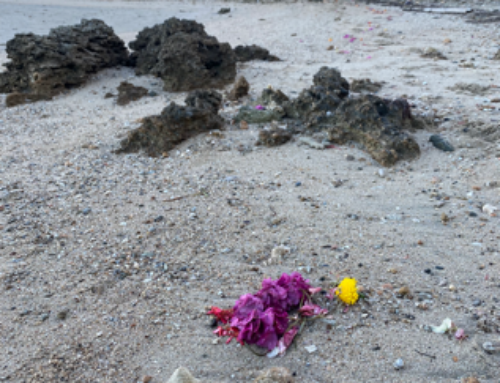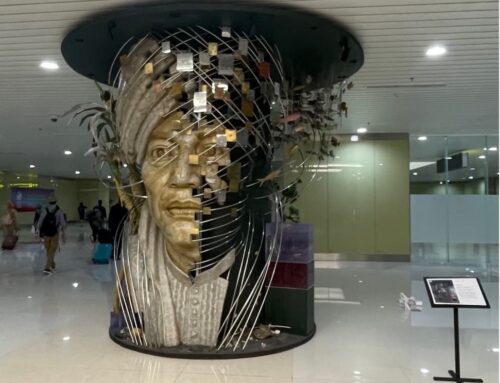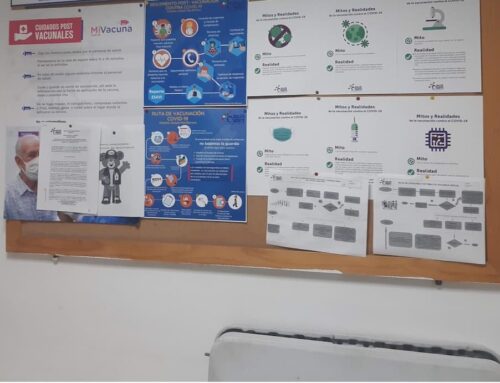
Tea Plucker and Seedling Tea Bush at the Ceylon Tea Museum. Photo by author.
I took this photo during the last week of 2008. I had begun my dissertation research in Sri Lanka’s Central Province one and a half months earlier. Two friends were visiting Kandy, the second largest city on the island and where I was based at the time. They suggested we visit the Ceylon Tea Museum, housed in a gutted tea factory on Hantane Estate outside Kandy town. I would later learn that the factory was built in 1925 at the height of British Ceylon’s tea industry. In the mid-1990s, Clifford Ratwatte, former Chairman of the Sri Lanka Tea Board, petitioned to have the museum open and chose Hantane for its proximate location to Kandy town. Incorporated under Sri Lanka’s Companies Act in 1998, the museum formally opened its doors to the public in December 2001.
We arrived at the main hall, which was mostly empty, apart from a few local visitors. As I stepped into the first room, a sudden rush of guilt overcame me—on one hand, for visiting such a touristy place while the civil war between the Government and Liberation Tigers of Tamil Eelam (LTTE) was raging and innocent civilians were dying and disappearing daily, and on the other, for spending time with friends. To compensate, I began photographing the restored machines that filled the room in the back of the first floor with my digital camera. I thought to myself: such images would be of some use in the future should a worker refer to them in conversation. The convergence of anticipatory states (Choi 2015) at the time makes my head throb now, as I write. My urgent desire to be one step ahead in research running against the Sri Lankan state’s violent drive to control the narrative of nation.
In my point-and-shoot frenzy, I snapped this photograph—one of twenty-four digital images I took during our visit that day. The coupling sculpture was the only semblance of life staged in the room. The sturdy dried skeletal branches of the tea bush were held up by a single shackle. The silvery tin-skinned, copper-ribbed sari-clad Tamil woman was identifiable by her red pottu; she wore red on her lips and a copper kudai (“basket”) on her back. Thin gold hoops pierced her ears, while her slim fingers hovered over the branches to pluck the bush’s invisible leaves. In this wartime curation of nationalist glory and factory-turned cabinet of curiosity, the steel woman and skeleton tea bush were haunting yet perfectly in place.
In fact, they were so in place, that between August 2019 and February 2023, I would visit Hantane two more times and never give either a second thought or glance. I was too occupied in the plantation’s archives, conducting research on the shooting of two Hollywood films on the estate’s grounds—Elephant Walk (1954) and Indiana Jones and the Temple of Doom (1984). In this project, I investigate how each cinematic production relied on the plantation’s labor ecologies to represent the country’s now known ethnonationalist futures.
Two months later, I gave a talk about these films at a university in the Boston area. Later that day, I visited Simone Leigh’s exhibit at the Institute of Contemporary Art with two colleagues. In the main atrium, Leigh placed her sculpture and installation, Last Garment (2022).1 The piece is a counter-imagining of C.H. Graves’ 1899 stereoscope, Mammy’s Last Garment, which features a Jamaican woman laundress washing a piece of clothing just past a river bank. No longer the rushing currents of the river in Graves’ double image, Leigh’s still pool reflects the room’s unmoving light brown walls. The water mirrors each bronze, steel, and metal crease of the woman’s dress, forcing you to center your focus on her body. You then see—beyond the act of washing—each of the 800 rosettes that adorn her hair and the strength of her muscles driving energy to her knuckles. Unlike Grave’s stereoscopic, Leigh’s sovereign creation reveals the contours and fullness of the woman’s feet under the water.
Viewing Leigh’s Last Garment made me return to the image I had taken on Hantane of the laboring couple—Tamil woman and tea bush. Her tea leaf basket, made of the same copper of her draped sari was blending into her back. One of the woman’s soles was the sculpture base, while the other was partially welded into an unfinished piece of cement. Everyone, including the tea plantation’s leeches and wasps, knows that the leaves of the tea bush would not have been plucked without her bloodied soles.
The image’s poor resolution forced me to zoom in on the pixels on my laptop screen until I could not get any closer. Even then, I could barely make out the three labels, but managed to read the following words:
TEA PLUCKER
donated by
Mr. CLIFFORD RATWATTE
Chairman
Sri Lanka Tea Board (2002)
Chairman—Ceylon Tea Museum
SEEDLING TEA BUSH
APPROX: 80 Years Old (1920)
donated by
BALASINGHAM BALAKUMAR
Superintendent
Hantane Estate
In Memory of my Grand Father
Chethupathy(?) Chinniah
Superintendent, Tennehena Estate,
Pita Bedera and
Father Chinniah Balasingam
Superintendent, Peenkande Group,
Nivithigala
If you knew nothing about Sri Lanka’s plantations, you might follow the patrilines inked on these labels in an effort to understand their histories. You might note their aspirational and scientific gestures to approximate the age of tea bushes while failing to register the age of the women plucking their leaves. You might leave this museum without knowing that only six years before the shackled skeleton seedling bush began to grow, W.G. Berry—superintendent of Peenkande Group, Nivithigala in Ratnapura District and acting plantation manager before grandfather and father Chinniah on the label—was starving to death the laborers working under him, forcing them to flee unlivable conditions, and finally arresting and detaining them in jail before court (Meyer 1998).
In “In Defense of the Poor Image,” Hito Steyerl (2009) suggests that the “poor image”—whose qualities are “bad” and resolutions “substandard,” often challenges the hierarchies of racial capital that the care, staging and high resolution of images such as Graves’ stereoscope reinforce and uplift: “It often defies patrimony, national culture, or indeed copyright. It is passed on as a lure, a decoy, an index, or as a reminder of its former visual self.” When the camera’s lens moves too quickly on the plantation, I now study its decoys for life-forces that challenge genealogical labels of prestige, patriarchy and property. To refuse the plantation’s patrilines is to index the abundance (Arondekar 2023) of an alternative plantation past. It travels beyond and below to an undersurface never intended to be seen or valued, but that stands deep to confront the nation’s fortune and glory.
Postscript
I returned to the Ceylon Tea Museum in August 2023 to find that the tea plucker and bush had been separated from one another. The bush still stands in the main room but now without its label. It balances on the ground in the company of another similarly leafless relic of a propagated bush. The plucker now stands alone on her reassembled feet in the corner of the museum reception room. Her sari has been painted a leaf-like dark green, and silver tin skin tinted a light blush. Her label is also nowhere to be seen.
Notes
1 Last Garment (2022) originally appeared in the 59th International Art Exhibition of La Biennale di Venezia in 2022 in Leigh’s exhibit, Sovereignty.
References
Arondekar, Anjali. 2023. Abundance: Sexuality’s History. Durham and London: Duke University Press.
Choi, Vivian Y. 2015. “Anticipatory States: Tsunami, War, and Insecurity in Sri Lanka.” Cultural Anthropology 30(2): 286–309
Meyer, Eric. 1998. “A Dramatic Episode of Labour Migration: Marathi ‘Coolies’ in the Sabaragamuwa Rubber Estates during the Early 20th Century.” Sabaragamuwa University Journal 1:11–28.
Steyerl, Hito. 2009. “In Defense of the Poor Image.” e-flux Journal 10 (November). https://www.e-flux.com/journal/10/61362/in-defense-of-the-poor-image/
Mythri Jegathesan is Associate Professor in the Department of Anthropology at Santa Clara University. She is author of Tea and Solidarity: Tamil Women and Work in Postwar Sri Lanka (University of Washington Press, 2019) and currently researching questions of postwar land attachment, caste, livelihood, and plantation relations in Sri Lanka’s Northern Province.
Cite as: Jegathesan, Mythri. 2024. “The Undersurface”. In “Photographic Returns,” edited by Christina Kefala and Ipsita Day, American Ethnologist website, 23 June. [https://americanethnologist.org/online-content/collections/photographic-returns/the-undersurface-by-mythri-jegathesan/]
This piece was edited by American Ethnological Society Digital Content Editor Katie Kilroy-Marac (katie.kilroy.marac@utoronto.ca).




